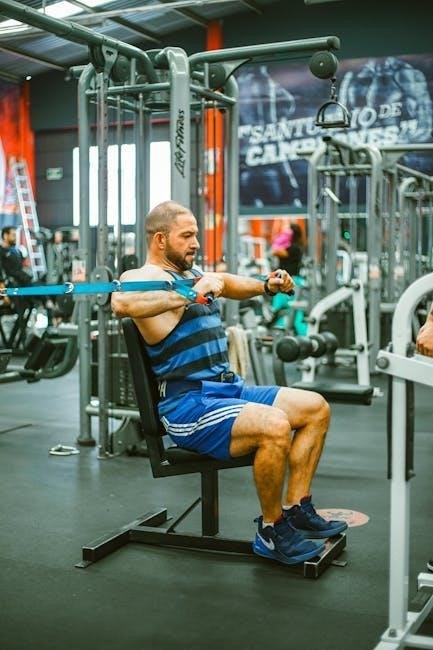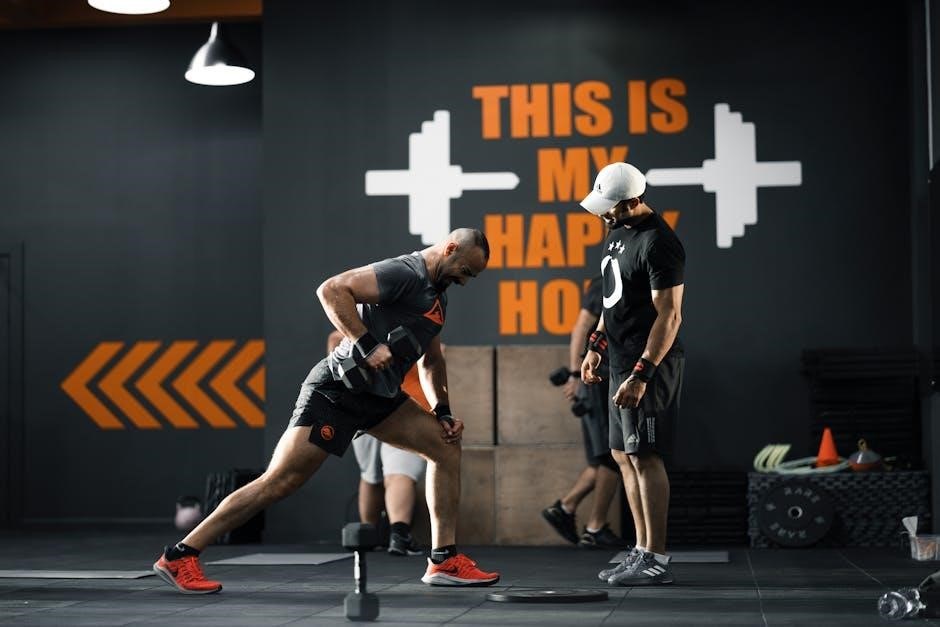Athletic workout programs provide structured routines to enhance physical fitness and performance. They offer progressive training plans, catering to all fitness levels, helping individuals build strength, endurance, and agility through consistent practice.
1.1 Definition and Importance of Athletic Workout Programs
Athletic workout programs are structured plans designed to enhance physical performance, improve overall fitness, and prepare individuals for specific sports or activities. These programs typically include a combination of strength training, cardiovascular conditioning, and flexibility exercises tailored to individual or team needs. The importance of athletic workout programs lies in their ability to build muscle, boost endurance, and improve agility, which are essential for athletes and fitness enthusiasts alike. By following a well-designed program, individuals can achieve specific goals, such as increasing speed, power, or stamina, while reducing the risk of injuries. Additionally, these programs promote mental toughness and discipline, which are critical for success in sports and other high-intensity activities. Whether for beginners or advanced athletes, athletic workout programs serve as a roadmap to achieving peak physical condition and maintaining long-term health. They are often available in PDF formats, making them easy to follow and implement consistently.
1.2 Benefits of Athletic Training for Overall Fitness
Athletic training offers numerous benefits for overall fitness, including increased strength, endurance, agility, and flexibility; It enhances cardiovascular health, improving heart function and lung capacity, which boosts energy levels and stamina. Regular athletic training also promotes weight management by burning calories and building lean muscle mass. Additionally, it strengthens bones and joints, reducing the risk of injuries and improving posture. Beyond physical benefits, athletic training fosters mental toughness, discipline, and focus, which are essential for achieving fitness goals. It also reduces stress and anxiety by releasing endorphins, creating a sense of well-being. For athletes and non-athletes alike, consistent training improves coordination and balance, enhancing overall physical performance. By incorporating a mix of strength, cardio, and flexibility exercises, athletic training provides a holistic approach to fitness, helping individuals maintain a healthy, active lifestyle. These benefits make athletic workout programs a valuable tool for anyone seeking to improve their physical and mental health.
Selecting the right athletic workout program involves assessing personal fitness goals, current fitness level, and availability of time and resources. It’s crucial to define whether the goal is to build muscle, improve endurance, or enhance overall fitness. Beginners should opt for programs that focus on foundational movements and proper technique, while intermediate athletes can explore hybrid or sport-specific routines. Consider the duration and frequency of workouts, ensuring they fit into daily schedules without causing burnout. Additionally, choose programs that offer clear instructions, demonstrations, and progression strategies to avoid plateaus. Consulting with a trainer or following established plans from reputable sources can guide the selection process. Prioritizing programs that include warm-up routines, recovery techniques, and nutritional advice ensures a well-rounded approach. Ultimately, the chosen program should align with individual objectives, provide measurable progress, and maintain long-term sustainability. This thoughtful approach helps maximize the effectiveness of any athletic workout program. Athletic workout programs vary to suit different needs: full-body routines for beginners, hybrid training combining strength and cardio, and sport-specific plans for advanced athletes to enhance performance and technique. Full-body workout programs are ideal for beginners, offering a comprehensive approach to building strength and endurance. These programs typically involve 3 days of training per week, targeting major muscle groups like legs, chest, shoulders, and back. A 12-week plan is common, introducing exercises such as squats, bench presses, and rows. The routines are designed to familiarize newcomers with gym equipment and basic techniques. Progression is gradual, ensuring safety and consistent improvement. Many programs include warm-ups and cool-downs to prevent injuries and enhance recovery. Full-body workouts promote overall fitness, improving coordination and muscle balance. They are versatile, accommodating different fitness goals, whether it’s building muscle or enhancing athleticism. For beginners, these programs provide a solid foundation, teaching proper form and consistency, which are essential for long-term success in any athletic training journey. Hybrid training programs are designed for intermediate athletes seeking to combine strength, conditioning, and cardiovascular fitness. These programs integrate elements from powerlifting, plyometrics, and bodyweight exercises to enhance overall athleticism. A typical hybrid program involves 4-5 sessions per week, balancing compound lifts like squats and deadlifts with dynamic movements such as box jumps and sprints. The structure allows athletes to improve explosive power, endurance, and muscle definition simultaneously. For example, a 6-week hybrid program might include strength-focused days, conditioning workouts, and mobility sessions to ensure well-rounded development. Hybrid training is versatile, catering to athletes aiming to boost sports performance or achieve a balanced physique. It emphasizes proper form and progressive overload to avoid plateaus and injuries. Many hybrid programs are supported by free PDF guides, providing detailed workout plans and nutrition advice for optimal results. This approach is ideal for those seeking a challenging yet sustainable routine to elevate their fitness journey. Sport-specific training programs are tailored for advanced athletes aiming to excel in their respective disciplines. These programs focus on enhancing skills and physical attributes directly relevant to the athlete’s sport, such as explosiveness for basketball or endurance for distance running. A 12-week program might incorporate Olympic lifts, plyometric exercises, and sport-specific drills to improve speed, agility, and power. For example, a basketball-focused routine could include box jumps and lateral sprints, while a soccer program might emphasize agility ladder drills and shuttle runs. Advanced athletes also benefit from periodized training, alternating between high-intensity phases and recovery periods to optimize performance. Many PDF guides offer detailed workout plans, including video demonstrations and nutrition advice, ensuring athletes follow a structured approach. These programs often require a high level of commitment and are designed to push athletes to their limits, preparing them for the demands of competitive sports. An effective athletic workout program includes warm-up routines, strength training, cardiovascular conditioning, and flexibility exercises. It also emphasizes proper nutrition and recovery strategies to ensure optimal performance and injury prevention. A proper warm-up and cool down are essential for optimizing athletic performance and reducing injury risk. A warm-up should include dynamic stretches, light cardio, and sport-specific movements to prepare the body for physical activity. This helps increase heart rate, activate muscles, and improve flexibility. Cooling down involves gentle exercises like static stretching, foam rolling, and deep breathing to gradually lower heart rate and promote recovery. Both routines enhance blood flow, reduce muscle soreness, and improve overall readiness for training or competition. Incorporating these practices ensures a safer and more effective workout experience, making them a cornerstone of any athletic workout program. Consistency in these routines is key to long-term health and performance gains. Strength training is a cornerstone of athletic development, focusing on building muscle mass and power. Key exercises include squats, deadlifts, bench presses, and overhead presses, which target major muscle groups. These compound movements enhance overall strength and athleticism; Progressive overload, gradually increasing weight or reps, is crucial for continuous muscle growth. Additionally, exercises like pull-ups, rows, and lunges improve functional strength. Proper form ensures safety and maximizes results. Periodization, cycling intensity and volume, prevents plateaus and promotes long-term gains. Strength training not only enhances performance but also reduces injury risk by strengthening connective tissues. For athletes, incorporating sport-specific movements, such as plyometrics or Olympic lifts, further tailors the training to their needs. A well-structured strength program is essential for achieving muscular development and peak athletic performance; Consistency and progression are key to unlocking full potential in any athletic endeavor. Cardiovascular conditioning is vital for enhancing endurance, allowing athletes to sustain prolonged physical efforts. Workouts like jogging, cycling, and swimming improve heart and lung efficiency, boosting stamina. High-Intensity Interval Training (HIIT) alternates intense bursts with recovery periods, optimizing cardiovascular fitness. Incorporating aerobic exercises, such as rowing or elliptical training, strengthens the heart and increases oxygen delivery to muscles; Consistency is key to adapt and improve endurance. For athletes, combining cardio with strength training ensures well-rounded fitness. Over time, enhanced cardiovascular health reduces fatigue, enabling better performance in sports and daily activities. A structured plan with varied exercises keeps workouts engaging and effective. Proper progression prevents burnout, ensuring steady improvement. Cardiovascular conditioning is fundamental for athletes seeking peak endurance and overall fitness. Flexibility and mobility exercises are essential for preventing injuries and enhancing athletic performance. Incorporating dynamic stretches, such as leg swings and arm circles, improves joint mobility and reduces muscle stiffness. Static stretches, like hamstring and quadriceps stretches, increase flexibility and range of motion. Mobility drills, including hip circles and thoracic rotations, help maintain joint health and prevent stiffness. These exercises are particularly important for athletes who engage in repetitive movements or high-intensity training. Proper flexibility and mobility routines can reduce the risk of strains, sprains, and overuse injuries. Consistency is key, as regular practice ensures long-term benefits. Athletes should also focus on foam rolling and self-myofascial release to improve muscle recovery and maintain optimal movement patterns. By prioritizing flexibility and mobility, athletes can enhance their performance while safeguarding against common injuries. These practices should be integrated into daily workout routines for overall athletic development and longevity. Nutrition and recovery are critical for optimizing athletic performance. A balanced diet rich in proteins, carbohydrates, and healthy fats fuels workouts and aids muscle repair. Adequate hydration and electrolyte balance are essential, while recovery techniques like rest and stretching prevent overtraining. A well-structured nutrition plan is essential for athletes to maximize performance and recovery. It should include a balanced intake of proteins, carbohydrates, and healthy fats, tailored to individual needs and training intensity. Protein is crucial for muscle repair and growth, while carbohydrates provide energy. Healthy fats support overall health and hormone production. Hydration is equally important, as water and electrolytes maintain performance and prevent dehydration. Meal timing is also key, with pre-workout meals providing sustained energy and post-workout nutrition aiding recovery. Athletes should avoid processed foods and focus on whole, nutrient-dense options. Personalized nutrition plans can be developed based on specific goals, such as weight management or endurance enhancement. Additionally, supplements like creatine or protein powder can be beneficial when combined with a balanced diet. A nutrition plan should be flexible to adapt to training phases and competition schedules, ensuring optimal fueling for peak performance. Effective recovery techniques are vital for muscle repair and growth, enabling athletes to perform at their best consistently. Adequate sleep, hydration, and nutrition form the foundation of recovery, with protein-rich diets and anti-inflammatory foods aiding muscle repair. Foam rolling, stretching, and compression garments can reduce muscle soreness and improve blood flow. Additionally, rest days and active recovery, such as light cardio or yoga, allow muscles to heal without overexertion. Ice baths and contrast showers are popular for reducing inflammation and speeding up recovery. Massage therapy can also break down scar tissue and promote muscle relaxation. Stress management techniques, such as meditation or deep breathing, further support recovery by reducing cortisol levels. Incorporating these practices into a routine ensures athletes can train harder and longer while minimizing the risk of injury or burnout. A well-rounded recovery plan is as essential as the workout itself for achieving optimal athletic performance and longevity. Periodization structures training into phases, ensuring alignment with athletic goals and preventing plateaus. Progression involves gradually increasing intensity, volume, or complexity to foster continuous improvement and peak performance at critical times. Periodization is a structured approach to training that divides the athletic preparation into specific phases. It ensures progressive overload and recovery, optimizing performance while minimizing overtraining risks. Annual plans are broken into macro-cycles, with each focusing on building foundational strength, power, or endurance. These cycles are further divided into meso-cycles, lasting 4-6 weeks, tailored to specific goals like speed or hypertrophy. Micro-cycles, typically weekly, balance intensity and recovery, allowing athletes to adapt and peak for competitions. Proper periodization ensures a logical progression, preventing plateaus and injuries. It aligns training with competition schedules, enhancing physical and mental readiness. By alternating high-intensity phases with recovery, athletes achieve long-term improvements. This systematic approach is crucial for maximizing performance and sustainability in sports. Progressing your workout routine safely is essential to avoid injury and ensure continuous improvement. Start by gradually increasing intensity, such as weight, repetitions, or volume. Incorporate advanced exercises only when proper form is mastered. Focus on consistency and patience, allowing your body time to adapt. Always warm up thoroughly and cool down to prevent muscle strain. Listen to your body and rest when needed to avoid overtraining. Recovery techniques, like stretching and hydration, support muscle growth and prevent fatigue. Track progress through journals or apps to monitor improvements and adjust routines accordingly. Avoid rapid changes to avoid burnout or injury. A well-planned progression ensures sustainable growth and long-term success in athletic training. Stay committed, and celebrate small achievements to maintain motivation and discipline in your fitness journey. Mental preparation is crucial for athletes, fostering resilience and focus. Building mental toughness and setting realistic goals enhances performance and consistency, ensuring a positive mindset throughout training and competition. Mental toughness is a critical component of athletic success, enabling athletes to perform under pressure and overcome challenges. It involves developing resilience, focus, and confidence. Techniques such as visualization, positive self-talk, and goal-setting are essential tools. Athletes can cultivate mental strength through consistent practice and mindfulness, allowing them to stay composed during high-stakes situations. A strong mindset enhances decision-making and adaptability, which are vital for peak performance. Additionally, understanding and managing emotions helps athletes maintain motivation and perseverance. Incorporating mental training into workout programs ensures holistic development, bridging the gap between physical skill and psychological fortitude. By prioritizing mental toughness, athletes can unlock their full potential and achieve their goals effectively. Setting realistic goals is essential for athletic development, as it provides direction and motivation. Goals should be specific, measurable, achievable, relevant, and time-bound (SMART). Start by identifying long-term objectives, then break them into smaller, manageable milestones. This approach ensures steady progress and maintains focus. Tracking achievements helps build confidence and identifies areas for improvement. Celebrating small victories reinforces commitment and sustains momentum. Regularly reviewing and adjusting goals keeps them aligned with current abilities and aspirations. A well-structured goal-setting plan fosters discipline and accountability, which are crucial for success in sports. By setting realistic goals, athletes create a clear roadmap to enhance their skills, stay motivated, and reach their full potential effectively. This systematic approach ensures continuous improvement and long-term success in athletic training. Avoiding injuries and common mistakes in athletic training requires proper warm-ups, correct form, and adequate recovery. Ignoring overtraining and poor techniques can lead to setbacks, so prioritize safety and consistency in your workout routine. Preventing injuries in athletic training involves a combination of proper warm-ups, cool-downs, and adherence to safe exercise techniques. Adequate stretching and strengthening exercises can significantly reduce the risk of muscle strains and joint-related injuries. Incorporating rest days and avoiding overtraining is crucial, as overexertion can lead to fatigue, which increases the likelihood of accidents. Additionally, wearing appropriate footwear and using correct equipment tailored to the specific sport or activity minimizes injury risks. It’s also essential to progressively increase workout intensity to allow the body time to adapt. Many athletic workout programs emphasize the importance of form and technique, often providing visual guides or instructional resources to ensure athletes perform exercises correctly. Prioritizing injury prevention not only enhances performance but also supports long-term participation in sports and fitness activities. One of the most common mistakes in workout programs is overtraining, which can lead to fatigue and injury. Many athletes overlook the importance of rest days, failing to realize that recovery is crucial for muscle growth and performance. Another mistake is poor form during exercises, which can result in ineffective workouts and increased injury risk. Some individuals also neglect to follow a structured plan, leading to inconsistent progress. It’s essential to avoid unrealistic expectations and focus on gradual improvements. Proper nutrition and hydration are often underestimated, yet they play a vital role in fueling workouts and supporting recovery. Ignoring these elements can hinder results and overall performance. By avoiding these common pitfalls, athletes can ensure safer, more effective training and achieve their fitness goals more efficiently. Implementing a well-structured athletic workout program enhances performance and reduces injury risks. Consistency, proper nutrition, and recovery are key. Explore resources for further guidance and continue progressing toward your fitness goals. Consistency and progression are key to achieving success in any athletic workout program. Always start with a clear goal and ensure your routine aligns with it. Focus on proper form to prevent injuries and maximize results. Gradually increase intensity to avoid plateaus and overtraining. Stay hydrated, prioritize recovery, and maintain a balanced diet to fuel your workouts. Incorporate mental strategies like visualization and positive affirmations to enhance performance. Seek guidance from professionals or online resources, such as PDF workout plans, to stay motivated and informed. Track your progress to celebrate milestones and identify areas for improvement. Remember, rest days are crucial for muscle repair and growth. Finally, stay flexible with your routine—adjustments are necessary as your fitness level evolves. By combining dedication, knowledge, and adaptability, you’ll achieve long-term success in your athletic training journey. To enhance your understanding and implementation of athletic workout programs, explore reputable resources such as fitness websites, training manuals, and expert-guided PDFs. Websites like Muscle & Strength and Ultimate Mathlet offer detailed workout plans, including full-body routines and sport-specific training. Downloadable PDFs, such as the 12-Week Beginner Training Routine and Hybrid Athlete Programs, provide structured guidance for all fitness levels. Additionally, books like Triphasic Training by Cal Dietz offer advanced insights into periodization and performance optimization. Join online fitness communities, such as forums or social media groups, to connect with athletes and coaches for tips and support. Consider enrolling in certification programs or workshops to deepen your knowledge of strength training and conditioning. Finally, subscribe to fitness journals or blogs for the latest research and trends in athletic development. These resources will empower you to refine your training and achieve your goals effectively.1.3 How to Choose the Right Athletic Workout Program

Types of Athletic Workout Programs

2.1 Full-Body Workout Programs for Beginners
2.2 Hybrid Training Programs for Intermediate Athletes
2.3 Sport-Specific Training Programs for Advanced Athletes

Components of an Effective Athletic Workout Program
3.1 Warm-Up and Cool Down Routines
3.2 Strength Training Exercises for Muscle Development
3.3 Cardiovascular Conditioning for Endurance
3.4 Flexibility and Mobility Work for Injury Prevention

Nutrition and Recovery for Athletic Performance
4.1 Nutrition Plan for Optimal Athletic Performance
4.2 Recovery Techniques for Muscle Repair and Growth

Periodization and Progression in Training
5.1 Understanding Periodization in Athletic Training
5.2 Progressing Your Workout Routine Safely

Mental Preparation and Mindset for Athletes

6.1 Building Mental Toughness for Sports
6;2 Setting Realistic Goals for Athletic Development

Avoiding Injuries and Common Mistakes
7.1 Preventing Injuries in Athletic Training

7.2 Common Mistakes to Avoid in Workout Programs
8.1 Final Tips for Implementing an Athletic Workout Program
8.2 Resources for Further Learning and Improvement
